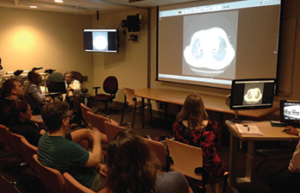At one time, I was the principle rheumatologist in three of our four combined clinics at our institution, and the knowledge, skills and relationships I acquired have been invaluable to my ability to better care for my patients. It opened a whole new world to me as I learned about such things as Borg scales, interface dermatitis with mucin deposition and the significance of finger-flexor weakness in patients with myositis.
Likewise, since I joined an ILD/rheumatology clinic, we have identified a large number of patients with antisynthetase syndrome and ANCA-associated ILD that could have otherwise gone unrecognized, and I have helped evaluate patients with IPAF (interstitial pneumonitis with autoimmune features). We include fellows, residents and occasionally medical students as part of the combined clinics, and the clinics are a favorite experience for many of them. We also have an autoimmune rotation for internal medicine residents, and the combined clinics are an integral part of the month-long rotation.
Does It Help Patients?

This MILD (multidisciplinary ILD) conference was attended by specialists in pulmonary ILD, rheumatology, pathology and radiology.
Do combined clinics make a difference for patient care? At the Group for Research and Assessment of Psoriasis and Psoriatic Arthritis (GRAPPA) meeting in 2016, Charis Gn, MD, reported on the Brown University experience with combined dermatology/rheumatology.3 She found that 33% of patients left the clinic with a modification or change in diagnosis, and in 20% of the psoriasis patients, a diagnosis of psoriatic arthritis was made or confirmed. Treatment escalation was prescribed for 41% of the psoriasis patients and 79% of the psoriatic arthritis patients.
In a systematic review of the literature regarding combined clinics focused on psoriasis and psoriatic arthritis, Cobo-Ibáñez et al. found the efficacy of therapy improved for patients involved in such clinics and patient satisfaction was higher with the combined experience than with separate visits.4 Overall, 94% of patients surveyed were very satisfied with the combination visits. Data also suggest that having a rheumatologist see these patients kept all joint pain from being labeled as psoriatic arthritis because 46% of the patients with psoriasis and joint pain had another cause for their musculoskeletal symptoms.
The down side? The scheduling wait time and the delay in being seen in clinic. Only 41% of patients were seen at their appointment time, which mirrors our experience at the clinics that employ the different-specialists, same-time strategy.
Samycia et al., from the Dermatology and Rheumatology Treatment Clinic in Vancouver, British Columbia, reported on their experience with a dermatology/rheumatology clinic.5 They found the combination of specialists proved very helpful for evaluating patients with rash and multiple systemic symptoms. They also found that 51% of lupus patients with rash had a non-lupus cause of the skin problem, such as rosacea, reminding us rheumatologists of the importance of Hickam’s dictum—that is, patients can have as many diseases as they darn well please.

